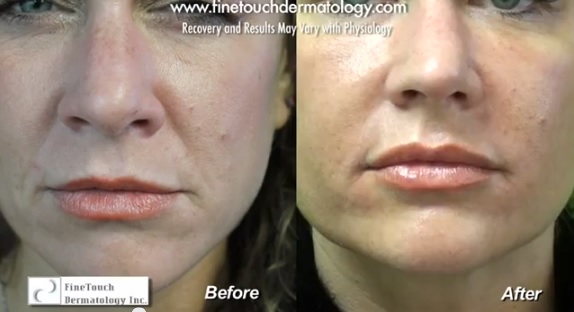The term laugh lines can refer to a couple different types of wrinkles. For example, crows feet can appear on the face when a person laughs. But perhaps more commonly, laugh lines are the grooves that develop around the nose and mouth. They are also known as nasolabial folds.
Nasolabial folds develop when the face loses volume. As such, they can create a sagging effect that makes a person look older.
This is why dermal fillers can offer an excellent solution for reversing this dynamic. Patients are able to regain the plumpness and fullness they had when they were younger.
Should Radiesse or Juvederm Be Used To Fill the Laugh Lines?
The choice of filler often depends on the objectives of the procedure. For example, here at Fine Touch Dermatology, we have used hyaluronic acid fillers like Juvederm for very mild forms of laugh lines. Juvederm will simply replenish the volume around the nose and sides of the mouth for a very soft and natural look.
However, severe nasolabial folds will require structural support to lift the depressed skin. In many cases, this is why Dr. Umar uses Radiesse for deeper laugh lines. Radiesse is made of tiny calcium hydroxyapatite microspheres suspended in a clear gel. The calcium based active ingredient helps encourage the development of new collagen fibers. These particles act in unison to form an adaptable matrix which can lift the fold. Depending on where it is injected, Radiesse can be used to fill soft tissue or areas that have more firmness. The microspheres will try to mimic their surroundings.
Besides the choice of product, what is also important is the ability of the doctor to create the desired outcome.
The Effects of Overfilling the Laugh Lines
For individuals with moderate laugh lines, filling in these grooves can do wonders for their appearance.
But for those with even deeper nasolabial folds, it is possible to achieve an over filled effect. This can happen if the doctor uses a large quantity of product to raise the depression in efforts to restore the original facial plane.
The laugh lines may develop hard ridges with this approach. And the area around the mouth may protrude and look muzzled due to having too much of the filler. Of course, other people will notice this.
Addressing the nasolabial areas alone can cause areas of the face to look mismatched. For very severe laugh line grooves, it is often necessary to create a more balanced appearance by adding appropriate amounts of filler to help raise the cheeks.
In other words, any protrusions that result from filling the deep lines around the mouth can look more even and natural by making the cheeks slightly more prominent.
Essentially the patient receives not only a treatment for their laugh lines, but also a cheek lift as well.
The duration of Radiesse is about eighteen months. However, renewing the filler through ongoing procedures allows the results to adapt to the face as it continues to change over time.
To learn more about Radiesse, click here.

